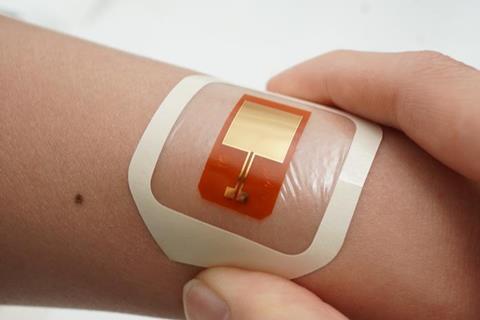Researchers at the University of Chicago and the University of California San Diego have made an exciting breakthrough in the battle against bacterial infections.
The Bozhi Tian (UChicago) and Gürol Süel (UC San Diego) labs have developed a cutting-edge bioelectronic device that taps into the natural electrical activity of certain bacteria found on our skin, paving the way for a drug-free approach to managing infections.

READ MORE: Living bioelectronics combine sensors and bacteria to heal skin
READ MORE: Unnoticeable electric currents could reduce skin infections
This groundbreaking study, published in DEVICE, reveals how programmable electrical stimulation can effectively reduce the harmful effects of Staphylococcus epidermidis, a common bacterium known for causing hospital-acquired infections and contributing to antibiotic resistance.
Patch delivers gentle electrical signals to bacteria
The device features a flexible electroceutical patch that delivers gentle electrical signals to bacteria at a specific skin pH level, leading to temporary changes in their behavior and preventing the formation of biofilms—clusters of bacteria that can lead to serious infections.
This innovative approach addresses the urgent need for new methods to tackle antibiotic-resistant infections, which are a growing concern for patient safety and healthcare systems around the globe. As recently reported, doctors estimate that drug-resistant infections are to increase 70% by 2050, making the development of this device and its accompanying treatments essential for safeguarding public health and ensuring effective infection control in an increasingly resistant microbial landscape.
Key Highlights of the Study Include:
- Targeted Activation: The device activates bacterial responses only in acidic environments, similar to healthy skin conditions.
- Reduced Virulence: The electrical stimulation significantly lowers the activity of harmful genes in bacteria and curbs their growth without relying on antibiotics.
- Localized Treatment: This technology allows for targeted therapy, reducing the potential side effects often associated with traditional antibiotic treatments.
In preclinical tests, the electroceutical patch demonstrated remarkable results, achieving nearly a tenfold reduction in bacterial colonization on pig skin. “We discovered action potentials in bacterial biofilms almost ten years ago and since then we have worked to show that bacteria, which are typically not thought of as excitable, are indeed excitable and even perform functions similar to neurons in the brain,” said Süel, a professor in the UC San Diego School of Biological Sciences.
“Our collaboration integrated our biological insights with the incredible technical and scientific expertise of the Tian group. Together we show that an important opportunistic pathogen is ‘selectively excitable,’ and the Tian group developed a wearable device that can treat biofilm infections on the skin through electroceutical therapy, without the need for any antibiotics.”
Use in treatment of chronic wounds
This research marks a significant step forward in bioelectronic medicine and researchers are optimistic that this device could soon be used in clinical settings, particularly for patients with chronic wounds or those who have medical implants. By harnessing the natural properties of bacteria, scientists can create more effective and personalized treatment options for those suffering from opportunistic infections.
Healthcare professionals are encouraged to explore the implications of this research for infection control and to stay updated on future advancements in bioelectronic therapies.







No comments yet